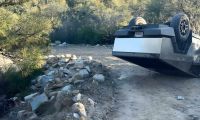Tesla's virtual power plant uses Powerwall energy storage systems that are voluntarily donated by their owners. They decide how much energy they want to transfer to the network and from that point Tesla handles what to do with this stored energy.
A good definition of a virtual power plant, as per electrek: "… a virtual power plant (VPP) consists of distributed energy storage systems, like Tesla Powerwalls, used in concert to provide grid services and avoid the use of polluting and expensive peaker power plants. Last year, Tesla launched a test VPP in California, where Powerwall owners would join in voluntarily without compensation to let the VPP pull power from their battery packs when the grid needed it".
In the event that a power (blackout, brownout) emergency occurs, and it is necessary to supply energy to the network in order to avoid more problems, the Powerwall will supply electricity respecting the limit set by its owner, beforehand. This is intended not only to avoid blackouts, but also to avoid resorting to thermal power plants, that are way less efficient and more polluting. But then, how much will Powerwall owners be compensated?

The great new feature of this system is that it benefits from the Emergency Load Reduction Program (ELRP), created by the California Public Utilities Commission (CPUC), that basically compensates customers who reduce or support demand of electricity during a grid emergency.
These emergency events came into operation last year and will last up until 2025. They are available between May and October from 4:00 p.m. to 9:00 p.m.; and the amount paid to the owner is $2 per kWh. Depending on the events and number of Powerwalls, between 10 and 60 dollars could be won for each event. This is a significant amount that gives an idea of how important virtual battery support is to the network when it needs more capacity. Tesla says it has around 50,000 Powerwalls in the region that could join the virtual power plant, adding up to 500 MWh of power.
As per the official announcement, any interested participant could "… become a part of the largest distributed battery in the world and help keep California’s energy clean and reliable. Opt-in to the Tesla Virtual Power Plant (VPP) with PG&E and your Powerwall will be dispatched when the grid needs emergency support. Through the Emergency Load Reduction Program (ELRP) pilot, you will receive $2 for every additional kWh your Powerwall delivers during an event. Adjust your Backup Reserve to set your contribution, while maintaining backup energy for outages”.

The importance of the use of backup batteries, which has been developing for years, is not minor. It offers a solution to enjoy a decentralized network that helps in an emergency and favors the storage of renewable energies. Along with the possibilities offered by technologies such as V2G ("Vehicle To Grid"), there are many new opportunities for a cleaner, safer and cheaper electric power network.
Source: electrek
All images courtesy of Tesla Inc.
Nico Caballero is the VP of Finance of Cogency Power, specializing in solar energy. He also holds a Diploma in Electric Cars from Delft University of Technology in the Netherlands, and enjoys doing research about Tesla and EV batteries. He can be reached at @NicoTorqueNews on Twitter. Nico covers Tesla and electric vehicle latest happenings at Torque News.












